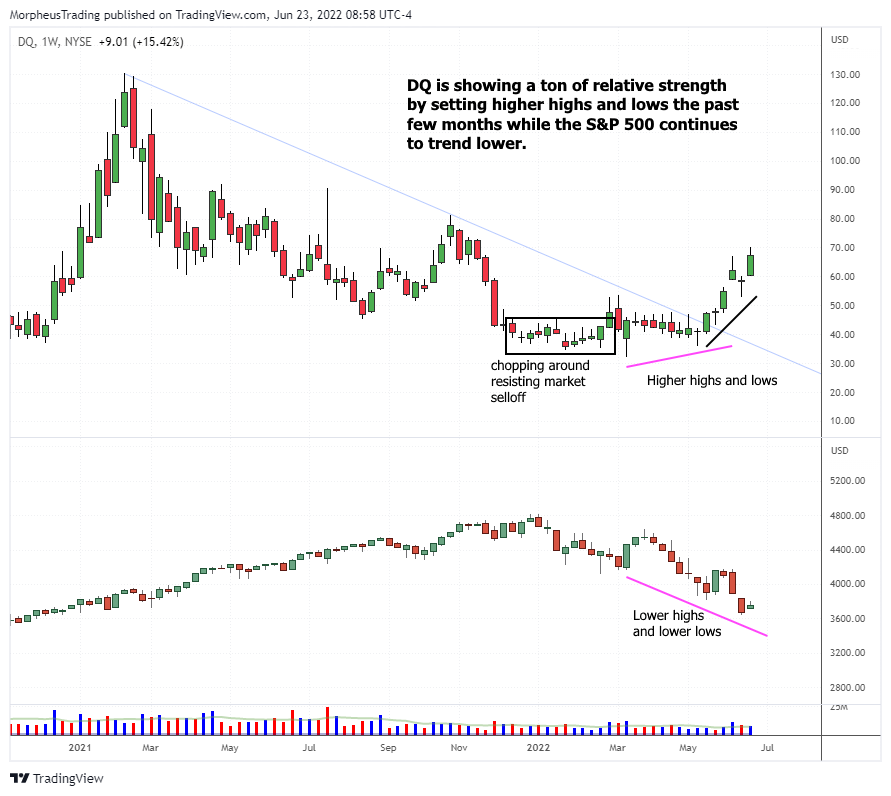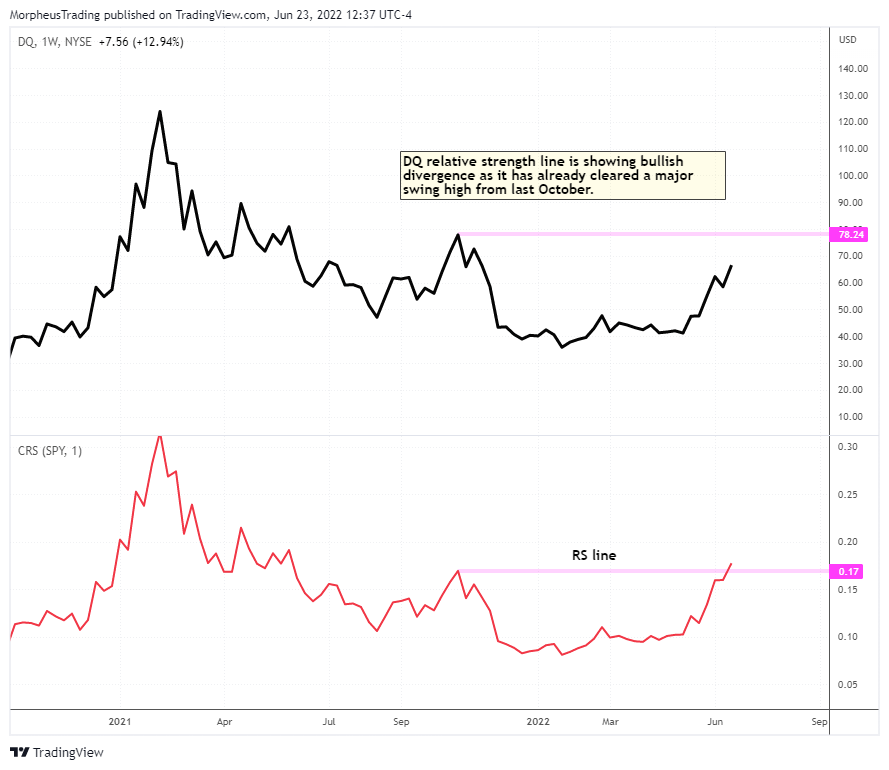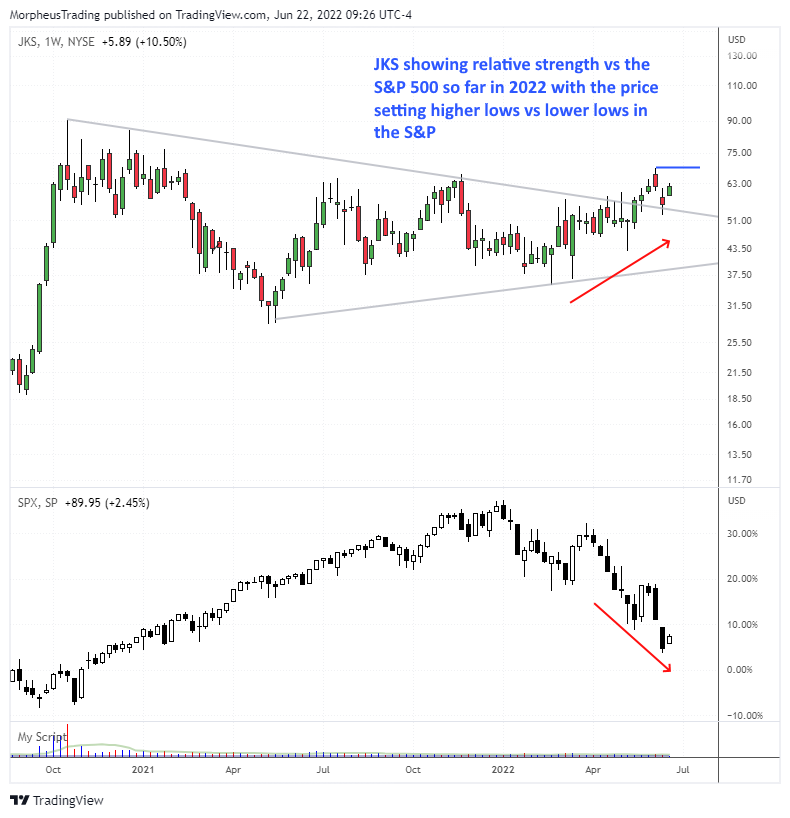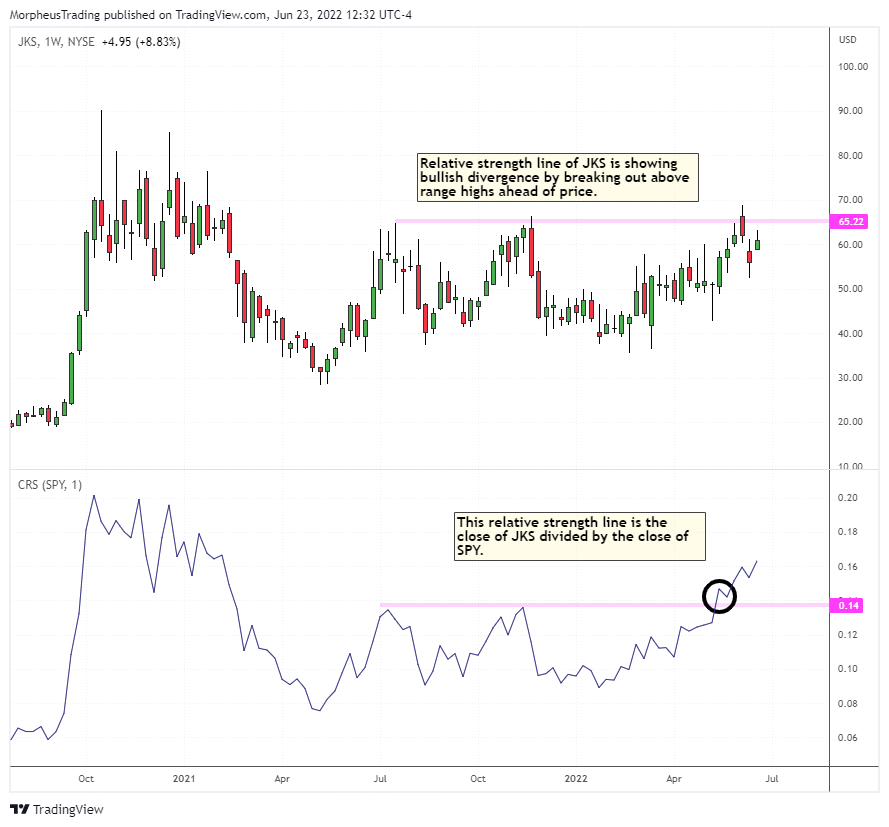
Relative Strength is a prime technique for consistently picking the best stocks for swing trading in both bull and bear markets. Here’s how you can start profiting from it today…
The amazingly reliable strategy of identifying relative strength has been the core foundation behind thousands of winning Morpheus stock picks since 2002.
In this article, we show you how relative strength trading works, including two actual examples of stock charts with high top relative strength.
Continue reading to discover how to dramatically improve your stock picking success with the power of relative strength trading!
How Relative Strength works to increase your trading profits
The basic concept of Relative Strength is to identify stocks that are outperforming the broad market indexes–in both up and down markets.
Stocks with high relative strength score bigger gains than the Nasdaq and S&P 500 during rallies, while also falling less when stocks move lower.
If a stock is so strong that it merely moves sideways while the Nasdaq is down sharply, what happens to the stock price when the Nasdaq eventually bounces as well?
The stock with top relative strength will be the first to explode higher and lead the Nasdaq.
Conversely, if the major indices suddenly sell off, stocks with high relative strength are usually the last to fall–and at a lesser percentage.
By focusing on high relative strength stocks, you automatically maximize your gains, while also reducing risk.
Relative strength forms the backbone of our swing trading system because it works incredibly well and is easy to implement.
Two ways to quickly and easily identify Relative Strength
Below are two methods for spotting stocks with high relative strength.
Both are equally effective; it’s just a matter of personal preference.
1. Pattern Relative Strength (visual comparison)
Pattern relative strength is a simple way of visually comparing the price action of any stock vs another (or an index), based on swing highs and lows.
For example, if stock A is setting higher lows while stock B is setting lower lows, then stock A’s pattern is showing relative strength.
Identifying pattern relative strength only requires manually comparing two chart patterns side by side and looking for bullish divergence (relative strength) between the patterns.
2. Relative Strength line (technical indicator)
In addition to visual comparison, a basic technical indicator known as the Relative Strength line (“RS line”) can be used for spotting relative strength.
The RS line is calculated by taking the closing price of one stock and dividing it by the closing price of another.
The result is then automatically plotted as a simple line on a chart.
In the examples below, the RS line tracks the price of the stock vs. the S&P 500 Index.
With the RS line, we take notice when the line diverges higher, away from the actual stock price.
NOTE: Do not confuse the relative strength line with the RSI indicator or IBD’s RS ranking.
Two hot stocks with relative strength now
Several stocks in the solar energy sector have caught our attention over the past few weeks.
Daqo New Energy ($DQ) and Jinko Solar ($JKS), both Chinese ADRs, are two of the strongest stocks in the sector now.
Their weekly charts have held up well so far this year, despite most major indexes being down 20-30% or more–a clear sign of relative strength.
Below, we show you the relative strength of both stocks using Pattern Relative Strength and the RS line.
Daqo New Energy ($DQ)
Pattern Relative Strength
The first chart below shows how Pattern Relative Strength is determined.
The price of $DQ is on the top panel and the S&P 500 Index is below:

Above, notice how $DQ chopped around during the first quarter of 2022, while the S&P 500 was setting lower lows.
The bullish divergence really became clear starting in March, as the price set higher highs and higher lows in June versus a plummeting S&P 500.
This is a clear example of Pattern Relative Strength.
Relative Strength Line
Next, check out the weekly chart of the same stock using the Relative Strength Line ($DQ vs. the S&P 500):

Note that the RS line (red line) is already above the prior swing high, while the price is still below.
This is bullish divergence of the RS line, which is exactly what we look for to find potential market leaders.
Jinko Solar ($JKS)
Pattern Relative Strength
$JKS has a similar weekly chart pattern as $DQ.
Below notice how $JKS was setting higher highs and lows since April, while the S&P 500 was setting lower highs and lower lows during the same period:

Relative Strength Line
The relative strength line of $JKS confirms the strength, as it has already broken out above range highs and continues to set higher highs while the price is still rangebound:

The greater the relative strength, the more obvious the pattern should jump at you.
If you are spending too much time analyzing whether or not a particular stock has high relative strength, it probably doesn’t!
Maintaining a Relative Strength Watchlist
Regardless of market conditions, it is never too early to build a watchlist of stocks showing high relative strength.
By always having an updated Relative Strength Watchlist ready, you can promptly take advantage of profitable trade opportunities when market conditions turn bullish.
Since market conditions can change quickly, astute traders are always prepared for the unexpected.
By the way, our daily swing trading report now includes full access to our weekly Relative Strength Watchlist–an awesome free bonus for all paid subscribers!
WHAT to buy–not WHEN to buy
We continually scan for high relative strength stocks to always know the best stocks for swing trading.
However, note that relative strength is only for finding the right stocks to buy–not for determining when to actually buy.
For example, after our Relative Strength Watchlist is in place, the Morpheus swing trading strategy relies on price, volume, and basic chart patterns to find ideal buy entry points.
Although we look for relative strength on the daily and weekly time frames, note that relative strength works just as well for shorter time frames (such as daytrading).
Summary
A successful trading system is one that can be easily and consistently be followed–regardless of market conditions.
The simple, “no nonsense” technique of relative strength trading is a fantastic way to always find the leading stocks in any market.
Pattern relative strength can be quickly spotted by simply looking for bullish divergence between any stock chart and an index chart.
Alternatively, just plot the relative strength line (not RSI) on TradingView or your favorite charting platform.
Then, patiently wait for ideal, low-risk entry points to greatly tip the odds of consistent stock trading success in your favor.
Need some help to take your trading to the next level?
Our flagship Wagner Daily service does the heavy lifting of finding the top relative strength stocks and providing you with our exact entry and stop prices every day.
Plus, SAVE BIG with our exciting 20-year anniversary promotion happening now!
Get started today to receive The Wagner Daily PRO service (includes Swing Trader Chatroom) at the cost of The Wagner Daily LITE.
